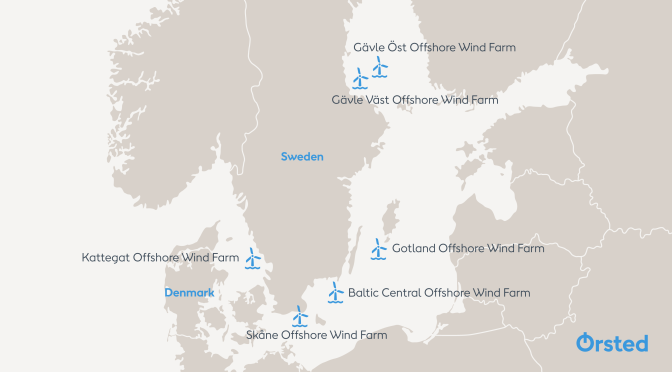Ørsted has applied for permits to build a further four large-scale offshore wind farms in Sweden, expanding its portfolio to a total potential capacity of 18 GW. If fully developed, the new wind farms could cover more than half of the Scandinavian country’s total electricity consumption.
The world’s first, largest and most experienced developer of offshore wind power sees significant demand for cost-effective, renewable electricity in Sweden. Pending permit approval and a construction plan for the offshore infrastructure, Ørsted aims to realize Sweden’s first commercial-scale offshore wind project, the Skåne offshore wind farm, by 2029.
With a clear regulatory framework for offshore wind energy, Ørsted believes that the four planned projects can be carried out in the next ten years. The new projects Ørsted is announcing today can deliver reliable, competitively priced, domestically produced power where it is needed most: in western, southern and central Sweden. With Sweden’s electricity consumption expected to double by 2035, new sources of energy are urgently needed. The delivery dates of Ørsted’s projects coincide with Svenska kraftnät’s grid expansion plans, so Ørsted can supply new electricity to the grid as soon as the TSO (Transmission Network Manager) is ready.
Swedish households need lower electricity prices and energy security. At the same time, companies want to access renewable electricity, be part of the green transition and boost their global competitiveness. Offshore wind can bring both to Sweden on a scale that makes a difference. With the addition of these four new offshore wind farms, Ørsted is committed to the long-term development of the Swedish offshore wind industry. In this sense, a stable regulatory framework would help offshore wind to meet Sweden’s electricity needs in the medium and long term and, in turn, meet the climate objectives set.
“Ørsted’s most advanced existing project in Sweden, the 1.5GW Skåne 1.5GW offshore wind farm, will be completed in 2029 if all relevant permits are obtained by 2023. Progress on the Skåne project is a a further step in Ørsted’s plans to become a major long-term investor and promoter of CO?-free energy derived from fossil fuels. I am looking forward to working with the administration and other interested local institutions to fulfill the government’s priority: a new electricity production that contributes to a rapid expansion of the supply system,” says Sebastian Hald Buhl, Country Manager of Ørsted in Sweden.”
“Sweden needs all the electricity production it can get, and offshore wind is clearly the fastest way to reach the volumes needed to reduce electricity prices. In turn, this cheapening reduces the need for public support for energy prices. Our offshore wind projects are strategically positioned to help reduce directly where it is needed most, and can help avoid costly onshore transmission upgrades to these key areas. That is why we believe that the offshore wind grid is a profitable investment for Sweden, emphasizes Jesper Kühn Olesen, Director of Development Projects for Ørsted offshore wind farms in Sweden.
Facts about the Ørsted offshore wind farms in Sweden
Skåne Offshore Wind Farm (existing project):
? Situated close to Ystad, Trelleborg and Skurup
? Production capacity of 1.5 GW, as much as half of Scania’s electricity consumption
? Will generate renewable electricity in 2029
Gotland offshore wind farm (existing project):
? Located off the southwest coast of Gotland
? Production capacity of 1.5 GW
? Will generate renewable electricity in 2032
Kattegat offshore wind farm (new project):
? Located close to Halmstad and Falkenberg
? Production capacity of up to 1.5 GW, higher than the electricity consumption of Värmland
? Will generate renewable electricity in 2032
Baltic Central Havsvindpark wind farm (new project):
? Located near Karlskrona
? Production capacity of up to 4 GW, more than Scania’s electricity consumption
? Will generate renewable electricity in 2032
Gävle East and Gävle West offshore wind farms (new projects):
? Situated on the outskirts of Gävle, Ävlkarleby, Tierp and Östhammar
? Production capacity of up to 5.5 GW + 4 GW, more than double that of Stockholm County
? They will generate renewable electricity in 2032


